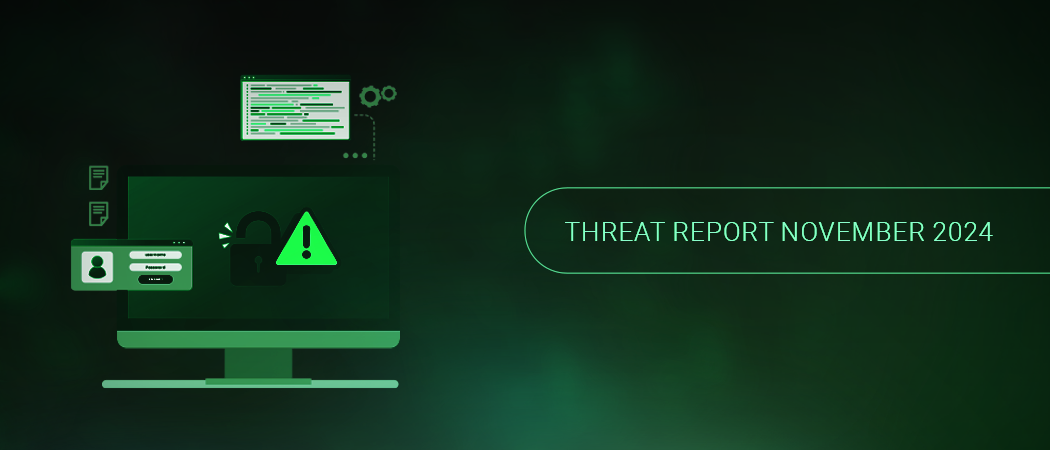November 2024 Threat Report: Vulnerability Management is Becoming Crucial
The world may be entering into a new phase of cyber, and a new technological paradigm. So-called “industry leading” or “enterprise grade” software is perpetually shown to be vulnerable with new critical vulnerabilities exposed and evidence of active exploitation on a weekly basis. Fancy new features keep us engaged but, considering the risk of fast-moving technologies, it’s important to work with organizations that keep things simple, stick to their core competencies and do things right.

In this November 2024’s edition of the Greenbone vulnerability report, we examine some recently released reports from the BSI and CISA to see what government cybersecurity agencies make of the current threat environment, then we follow up with news of the most pressing and actively exploited vulnerabilities in this month. Considering the high degree of risk presented by the current landscape of cybersecurity threats, it’s important to prioritize the fundamentals of IT security – and software design – to avoid building operations on a proverbial house of cards.
BSI Releases Its Annual IT Security Summary for 2024
Policy in the EU continues to rapidly evolve in response to increasing cyber risk. Cybersecurity for all requires cross-border cooperation on many levels. According to the 2024 summary report, the German Federal Office for Information Security (BSI) is focused on harmonizing national specifications with cybersecurity best practices while considering the economic and technical feasibility of new measures. Referred to as the “Europeanisation of Cybersecurity”, European standardisation and Germany’s collaboration with the three European Standardisation Organisations CEN, CENELEC and ETSI promote a risk-based approach to enforcing security best practices among critical infrastructure and providers of virtually all digital products.
Regarding the Cyber Resilience Act (CRA), each member state will have authority to remove non-compliant products from the market and penalise offending vendors. “Important products” (Class I), such as password managers and routers, must follow harmonised European standards (hEN). Regarding NIS2, the BSI received 726 reports representing 141 incidents from critical infrastructure facilities so far in 2024. This includes sectors like healthcare, energy, water, food, IT and telecommunications, financial and insurance services, among others.
The BSI also observed an overall increase in new malware variants and 256% increase in malware exploiting Windows. Reading the full report relays trends in attacker behaviors such as an increase in Bring Your Own Vulnerable Driver (BYOVD) attacks capable of disabling EDR security products. There were also ongoing efforts to sinkhole botnets that contribute to mass exploitation attacks at scale, and the continuing fragmentation of cybercrime activities into initial access brokering and second stage ransomware groups.
How do these observations pertain to Greenbone and vulnerability management in general? While effective vulnerability management and compliance auditing are only one piece of the enterprise cybersecurity puzzle, closing known security gaps and regularly attesting strong security configurations is a critical core competency that all organizations need to master.
CISA’s Most Exploited Vulnerabilities of 2023 Are Revealing
The 2023 Top Routinely Exploited Vulnerabilities report from the Cybersecurity & Infrastructure Security Agency (CISA) observed an increase in exploited zero-day vulnerabilities compared to 2022 and their use in attacks on high-priority targets. Other than zero-days, the report lists the top 47 CVEs (Common Vulnerabilities and Exposures) exploited by attackers. Networking (40%) and productivity software (34%) make up the vast majority of highly targeted CVEs. There is also a strong trend in the type of software flaws most exploited. Mishandling untrusted input accounts for 38% of the most attacked software flaws, while improper authentication and authorization make up 34%. Sadly, considerations for securing these flaws are elementary, covered in application design 101. Also, 90% of the top exploited vulnerabilities in the report are in closed source proprietary products indicating that cyber criminals are not hindered by reverse engineering barriers.
While the EU is motivated to improve security via legal requirements, CISA continues its plea for software vendors to employ Secure by Design principles during development stages. They also suggest that more pay-to-hack bug bounty programs could incentivize ethical security researchers.
Multiple Critical Flaws in Palo Alto Products Attacked
On November 8, 2024, Palo Alto Networks issued a security advisory revealing a zero-day remote code execution (RCE) vulnerability affecting its PAN-OS operating system. The advisory was soon updated after evidence of active exploitation emerged. Here is a summary of new vulnerabilities in Palo Alto products disclosed in November 2024.
- CVE-2024-0012 (CVSS 9.8 High): An authentication bypass in PAN-OS allows unauthenticated access to administrator privileges. Attackers may perform administrative actions, tamper with the configuration, or exploit other authenticated privilege escalation vulnerabilities like CVE-2024-9474.
- CVE-2024-9474 (CVSS 7.2 High): A privilege escalation vulnerability in PAN-OS software allows PAN-OS administrators to perform actions on the firewall with root privileges.
- CVE-2024-9463 (CVSS 7.5 High): An OS command injection vulnerability in Expedition allows an unauthenticated attacker to run arbitrary OS commands as root. This allows unauthorized disclosure of usernames, cleartext passwords, device configurations and device API keys of PAN-OS firewalls.
- CVE-2024-9465 (CVSS 9.1 High): SQL injection could allow an unauthenticated attacker to reveal Expedition database contents, such as password hashes, usernames, device configurations and device API keys, or create and read arbitrary files on the Expedition system.
- CVE-2024-5910 (CVSS 9.8 High): Missing authentication for a critical function in Expedition can lead to admin account takeover remotely and expose configuration secrets, credentials and other data.
Greenbone is able to detect all new CVEs published in Palo Alto devices in November 2024. Ideally, ensure networking management interfaces are not accessible via the public Internet and for best practices, use firewall configuration to prevent access from unauthorized internal network endpoints.
US Critical Telecom Infrastructure Breached
The recent breaches involving major US telecom providers serves as a stark warning to all organizations operating complex IT infrastructure at scale. Blame has been laid on Chinese backed hacking groups who reportedly used the access to intercepted U.S. political officials’ calls, SMS text-messages and intercepted mobile metadata. According to Adam Meyers, vice president of intelligence at CrowdStrike, by compromising the telecoms directly, threat actors circumvent the need for breaching the individual networks of their targets. Considering the sheer number of critical vulnerabilities in products from US networking vendors such as Palo Alto Networks, Oracle, Cisco, Citrix, Ivanti, Broadcom, Microsoft and Fortinet more intensive application security testing would greatly reduce the risk to their core customers – US companies at home and abroad, and other large global firms.
Liminal Panda, Salt Typhoon, Volt Typhoon and others are known to attack “shadow IT” – legacy mobile protocols that IT administrators are not aware is still active or actively monitoring. Sophisticated, highly skilled APT actors are highly adaptable and have the resources to develop malware for virtually any known vulnerability that is exploitable, as well as actively develop zero-day exploits yet unknown.
5 Privilege Escalation Flaws Found in Ubuntu’s Needrestart
A flaw in Ubuntu’s Needrestart feature could allow an unprivileged local attacker to execute shell commands as root user. The new CVEs impact all versions of Needrestart going back to 2014. Needrestart determines whether any processes need to be restarted after systemwide packages are updated to avoid a full reboot and is invoked by the apt package manager. The vulnerability is caused when untrusted data such as environment variables are passed unsanitized to the Module::ScanDeps library which executes as root. These user-level environment variables can also influence Python and Ruby interpreters during Needrestart’s execution.
The vulnerabilities can be mitigated by updating Needstart to a patched version or by disabling the interpreter scanning feature by setting $nrconf{interpscan} = 0 in the needrestart.conf configuration file. Greenbone includes detection for all CVEs related to Needrestart feature [1][2][3].
Here is a brief description the newly disclosed CVEs:
- CVE-2024-11003 (CVSS 7.8 High): Unsanitized data passed to the Module::ScanDeps library could allow a local attacker to execute arbitrary shell commands.
- CVE-2024-10224 (CVSS 5.3): Unsanitized input passed to the Module::ScanDepscan library allows execution of arbitrary shell commands by opening a “pesky pipe” (such as passing “commands|” as a filename) or by passing arbitrary strings to eval().
- CVE-2024-48990 (CVSS 7.8 High): Allows local attackers to execute arbitrary code as root by tricking Needrestart into running the Python interpreter via the PYTHONPATH environment variable.
- CVE-2024-48991 (CVSS 7.8 High): Allows local attackers to execute arbitrary code as root by winning a race condition and pointing Needrestart to a fake Python interpreter instead of the system’s real Python interpreter.
- CVE-2024-48992 (CVSS 7.8 High): Allows local attackers to execute arbitrary code as root by tricking needrestart into running the Ruby interpreter via the RUBYLIB environment variable.
Is Third Time the Charm for VMware vCenter Critical RCE Flaws?
VMware has been grappling with the challenge of effectively patching critical vulnerabilities in its vCenter server products. Broadcom, which owns VMware, initially released patches in September for two significant vulnerabilities in vCenter, CVE-2024-38812 (CVSS 9.8 High) classified as a heap-overflow vulnerability in the implementation of the DCERPC protocol, and CVE-2024-38813 (CVSS 9.8 High) which offers privilege escalation via specially crafted network packets.
However, these initial patches were insufficient, prompting a second round of patches in October. Despite these efforts, it was confirmed in November that the CVEs were still vulnerable and had been exploited in the wild. vCenter is a prime target for attackers due to its widespread use, and the situation highlights ongoing security challenges. VMware users should apply patches promptly. When CVEs such as these in VMware vCenter are updated with new information, Greenbone’s team of security analysts reviews the changes and updates our vulnerability tests accordingly.
Helldown Ransomware Exploiting Zyxel and Its Customers
In November 2024, a Linux variant of the Helldown ransomware payload was discovered. Helldown is known to exploit the IPSec VPN of Zyxel devices via CVE-2024-42057 (CVSS 8.1 High) for initial access. After gaining a foothold, Helldown steals any accessible credentials and creates new users and VPN tunnels to maintain persistence. The new variant targets VMware ESXi virtual machines to exfiltrate their data and encrypt them. This technique is shared by other ransomware groups such as the Play gang.
The Helldown ransomware group is considered an emerging threat, claiming over 30 victims since August, including the maker of Zyxel products themselves. Zyxel has issued an article acknowledging the attacks with mitigation instructions and Truesec has published known Helldown TTP (Tactics Techniques and Procedures) from their response efforts. Greenbone is able to detect all vulnerabilities known to be associated with Helldown ransomware attacks including CVE-2024-42057 in Zyxel products [1][2][3] as well as known software vulnerabilities used by other ransomware threat actors to gain initial access, escalate privileges and move laterally to high value targets within the victim’s network.
Summary
From EU policy advancements to CISA’s insights on exploited vulnerabilities: the critical need for better software development practices, effective vulnerability management and defense in depth is evident. November’s events, such as Palo Alto’s zero-days, Ubuntu’s Needrestart flaws and VMware vCenter’s ongoing challenges, emphasize the importance of timely monitoring and patching of critical infrastructure. Emerging threats like Helldown ransomware reinforce the need for proactive defense strategies. Greenbone continues to support organizations by detecting critical vulnerabilities, providing actionable insights and advocating for a security-first approach with fundamental IT security best practices.
Joseph has had a varied and passionate background in IT and cyber security since the late 1980s. His early technical experience included working on an IBM PS/2, assembling PCs and programming in C++.
He also pursued academic studies in computer and systems engineering, anthropology and an MBA in technology forecasting.
Joseph has worked in data analytics, software development and, in particular, enterprise IT security. He specialises in vulnerability management, encryption and penetration testing.



